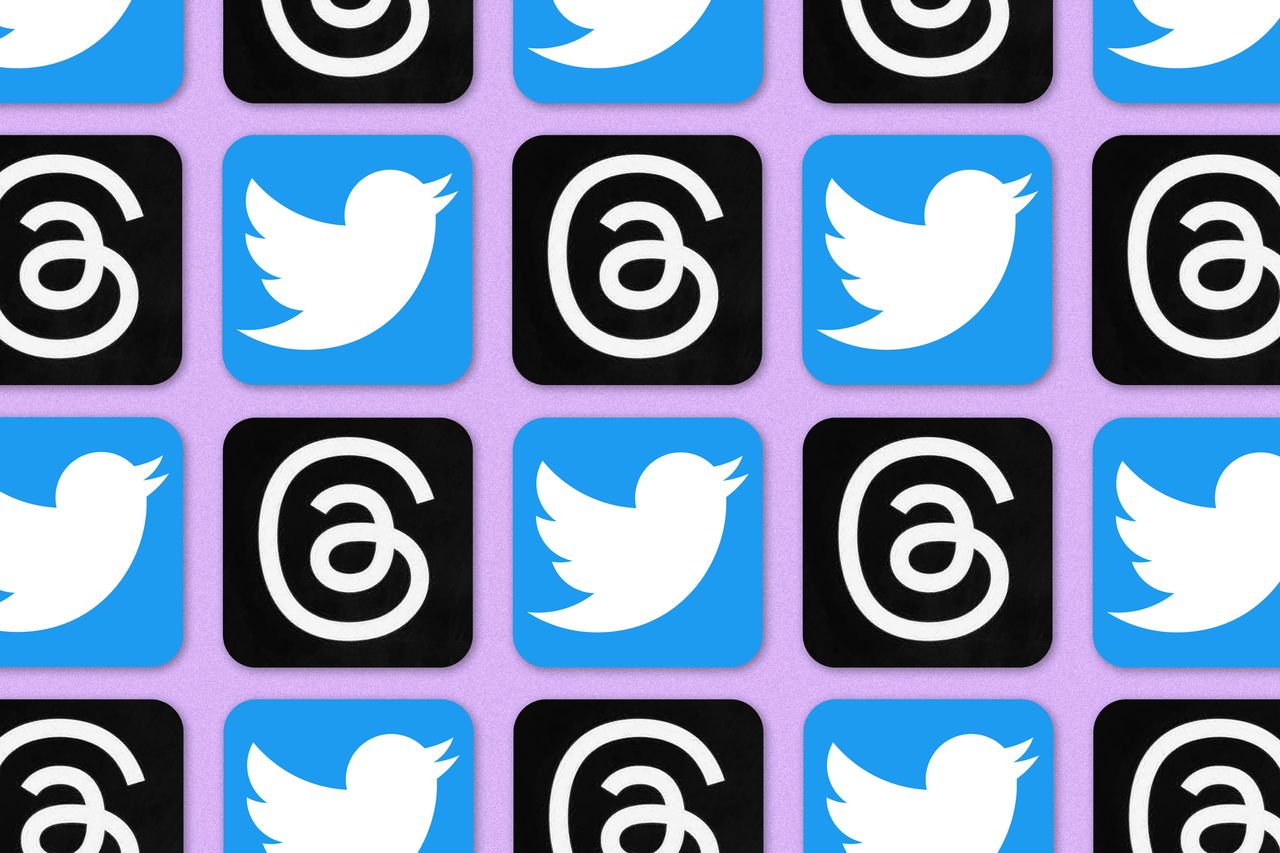Threads vs. Twitter: What’s the Difference?
The Instagram-linked app joins the crowded microblogging fray
If you’re wondering what it’s like to use the new Threads app, just close your eyes and picture Twitter but with a lot less Elon Musk—and that’s exactly the point.
Meta—owner of Instagram, Facebook and WhatsApp—on Wednesday launched its latest service, called Threads. While linked to Instagram (you even need an Instagram account to sign up for Threads), the new app’s primary focus is sharing short snippets of text. Users can post up to 500 characters or share videos up to five minutes long.
Welcome to Mark Zuckerberg’s new Metaverse. No virtual-reality spectacles or legless 3-D avatars here. Just good ol’ fashioned words…in a good ol’ fashioned social-media feed…on your good ol’ fashioned smartphone.
“There’s a hunger for something new,” Connor Hayes, Meta’s vice president of product, said in an interview. He added that public figures and creators have specifically been looking for an alternative to Twitter that “feels more productive and positive.”
Since Musk took over Twitter in October, the company has had numerous technical issues, changed its blue-check-mark verification policies and faced criticism from users and advertisers for how it moderates content. This past weekend, Musk limited how many posts users could see, saying he wants to combat “extreme levels of data scraping.”
That’s left a potential opening for competitors. There’s Mastodon, Bluesky, Spill. Is Threads any better than those? Are there privacy concerns—as with other Meta apps? Is it easy to set up and close a Threads account? Can Twitter actually be beaten?
Here are our answers and first impressions after using the app for the past day.
What is Threads? And how do I use it?
Threads is Meta’s latest social-media app, and this one directly takes on Twitter with short missives you can share with followers. It lets you post text, photos, links and videos.
Thanks to some serious Twitter copying and pasting, Threads is simple to use. Download the iOS or Android app and you’ll be prompted to log in with your Instagram account and fill out your Threads profile. You can choose to keep following the same people you follow on Instagram or pick just some of them—or none at all.
The Home tab includes a feed of posts. Tap the button with an abstract-looking paper and pen to compose a new Thread, and tap the paper clip icon to add a photo or video. You can mention other people by using the @ symbol in front of their usernames and “repost.”
The app is available in more than 100 countries, though not in the European Union.
Wait, I already have Instagram! Do I have to download a separate app?
You can’t join Threads without an Instagram account, but the new service operates as its own app. Do we really need another app on our phones? Nope, but here we are.
If you really don’t want to download another app, you can access the service from the Threads.net website, similar to how you can use Instagram in a browser. Hayes said there are no plans right now for a dedicated Mac or Windows app.
I tried Threads and want to delete it. What happens to my Instagram account?
Because of the Instagram integration, setting up Threads is fast and easy. Quitting it—not so much. You can’t completely delete your Threads profile unless you also delete your Instagram account, the app’s privacy policy says.
If you really don’t want to use Threads but want to keep Instagram, you can deactivate your account, which hides your profile, Threads, replies and likes. Deactivating Threads doesn’t impact your Instagram account.
Adam Mosseri, the head of Instagram, on Thursday said that because Threads is powered by Instagram, it’s currently one account. “But we’re looking into a way to delete your Threads account separately,” he said on Threads.
What does Threads have that Twitter doesn’t?
On the surface Threads is a Twitter clone, but dig deeper and you can find some real differences:
- Instagram integration: Because Threads is so closely linked to your Instagram account, you don’t have to start from scratch when it comes to finding your friends and others to follow. People you’ve blocked on Instagram will carry over, and you can share Threads to your Instagram Stories.
- Decentralised support: Threads will be compatible with ActivityPub, a decentralised social-networking protocol—the same one used by Mastodon. What does that mean? It is “decentralised” because hosting of accounts, including people’s followers, can be done on independent servers, rather than those operated privately by a single company. This is the way Meta currently runs Facebook and Instagram. Ultimately, it could give users more freedom to take their followers and information when they leave the service, and allows you to view posts from other social-media networks that support the protocol. There’s no specific date when ActivityPub will roll out, Hayes said.
- Rate limit: Twitter this past weekend limited the number of posts users can read to 600 a day for unverified accounts and 6,000 a day for those paying a monthly subscription fee. Threads imposes no limit or boundaries, whether you’re verified or not.
What does Twitter have that Threads doesn’t?
It takes just a few minutes of using Threads to see where Meta rushed things. “There are a bunch of features that are coming that weren’t quite ready for launch,” Hayes said.
Here are some features found on Twitter that we expect on Threads:
- Follower feed: Right now there is just the one main algorithmic feed, which includes posts from people you follow and others that are popular on the service. You can’t see a feed of just the people you follow or a purely chronological feed.
- Edit button: You cannot edit your posts after you’ve posted.
- Character count: How are we supposed to know when we’re blabbing away when there’s no indicator that you’re nearing the 500-character limit?
- Search: You can search for other accounts but not for words contained in posts. There is also no support for hashtags yet.
- Direct messaging: You can’t send private messages through Threads. You’ll have to head back to Instagram for that.
- Ads: There are no ads on Threads—at least for now. “The priority for this launch is to make the app as great as possible for consumers and creators,” Hayes said. “And we haven’t prioritised ads as a part of this.” (Translation: There will eventually be ads.)
Who is on Threads?
Well, us. (Follow WSJ here, Joanna here and Ann-Marie here!) But we certainly cannot sing like Shakira and Nick and Joe Jonas. Or act like Zooey Deschanel and Beanie Feldstein. Or tell jokes like Ellen DeGeneres and Jack Black. Or stream shows like Netflix or cook up burgers like Shake Shack. Or even take off into the skies like American Airlines. Big names and companies seem to be joining the service by the minute.
What about my privacy on Threads?
Check the Threads listing in the Apple App Store and you’ll see that Meta may collect loads of data from the app: Health & Fitness, Purchases, Financial Info, Location, Contacts…The list goes on.
Hayes said that list doesn’t give much context about why or under what circumstances that sort of data would be used. Instead, he pointed us to Threads’s two privacy policies: the Meta privacy policy and a new supplemental Threads-specific policy due to the coming ActivityPub integration. Threads also allows you to designate your account and your posts as public or private.
Still, this is Meta we’re talking about. If you have been a Facebook or Instagram user, it has built up quite a bit of data about you over the years. Expect this to just be another app that feeds into that.
Is this it? A real Twitter competitor?
It sure looks like the closest thing to it. Threads has an edge over most Twitter competitors because it uses Instagram to immediately build your following and populate your feed. Heck, in just the first four hours, it had over five million sign-ups, according to Zuckerberg’s own Thread. The app hit 30 million sign-ups as of Thursday morning, he posted.
But as Zuckerberg (or an actor playing him) was once famously told, sort of: “Thirty million sign-ups isn’t cool. You know what’s cool? A billion sign-ups.”
(OK, that might not happen this week, but it’s probably what he’s aiming for.)
 Copyright 2020, Dow Jones & Company, Inc. All Rights Reserved Worldwide. LEARN MORE
Copyright 2020, Dow Jones & Company, Inc. All Rights Reserved Worldwide. LEARN MORE
Pure Amazon has begun journeys deep into Peru’s Pacaya-Samiria National Reserve, combining contemporary design, Indigenous craftsmanship and intimate wildlife encounters in one of the richest ecosystems on Earth.
Australia’s housing market defies forecasts as prices surge past pandemic-era benchmarks.
JPMorgan Chase has a ‘strong bias’ against adding staff, while Walmart is keeping its head count flat. Major employers are in a new, ultra lean era.
It’s the corporate gamble of the moment: Can you run a company, increasing sales and juicing profits, without adding people?
American employers are increasingly making the calculation that they can keep the size of their teams flat—or shrink through layoffs—without harming their businesses.
Part of that thinking is the belief that artificial intelligence will be used to pick up some of the slack and automate more processes. Companies are also hesitant to make any moves in an economy many still describe as uncertain.
JPMorgan Chase’s chief financial officer told investors recently that the bank now has a “very strong bias against having the reflective response” to hire more people for any given need. Aerospace and defense company RTX boasted last week that its sales rose even without adding employees.
Goldman Sachs , meanwhile, sent a memo to staffers this month saying the firm “will constrain head count growth through the end of the year” and reduce roles that could be more efficient with AI. Walmart , the nation’s largest private employer, also said it plans to keep its head count roughly flat over the next three years, even as its sales grow.
“If people are getting more productive, you don’t need to hire more people,” Brian Chesky , Airbnb’s chief executive, said in an interview. “I see a lot of companies pre-emptively holding the line, forecasting and hoping that they can have smaller workforces.”
Airbnb employs around 7,000 people, and Chesky says he doesn’t expect that number to grow much over the next year. With the help of AI, he said he hopes that “the team we already have can get considerably more work done.”
Many companies seem intent on embracing a new, ultralean model of staffing, one where more roles are kept unfilled and hiring is treated as a last resort. At Intuit , every time a job comes open, managers are pushed to justify why they need to backfill it, said Sandeep Aujla , the company’s chief financial officer. The new rigor around hiring helps combat corporate bloat.
“That typical behavior that settles in—and we’re all guilty of it—is, historically, if someone leaves, if Jane Doe leaves, I’ve got to backfill Jane,” Aujla said in an interview. Now, when someone quits, the company asks: “Is there an opportunity for us to rethink how we staff?”
Intuit has chosen not to replace certain roles in its finance, legal and customer-support functions, he said. In its last fiscal year, the company’s revenue rose 16% even as its head count stayed flat, and it is planning only modest hiring in the current year.
The desire to avoid hiring or filling jobs reflects a growing push among executives to see a return on their AI spending. On earnings calls, mentions of ROI and AI investments are increasing, according to an analysis by AlphaSense, reflecting heightened interest from analysts and investors that companies make good on the millions they are pouring into AI.
Many executives hope that software coding assistants and armies of digital agents will keep improving—even if the current results still at times leave something to be desired.
The widespread caution in hiring now is frustrating job seekers and leading many employees within organizations to feel stuck in place, unable to ascend or take on new roles, workers and bosses say.
Inside many large companies, HR chiefs also say it is becoming increasingly difficult to predict just how many employees will be needed as technology takes on more of the work.
Some employers seem to think that fewer employees will actually improve operations.
Meta Platforms this past week said it is cutting 600 jobs in its AI division, a move some leaders hailed as a way to cut down on bureaucracy.
“By reducing the size of our team, fewer conversations will be required to make a decision, and each person will be more load-bearing and have more scope and impact,” Alexandr Wang , Meta’s chief AI officer, wrote in a memo to staff seen by The Wall Street Journal.
Though layoffs haven’t been widespread through the economy, some companies are making cuts. Target on Thursday said it would cut about 1,000 corporate employees, and close another 800 open positions, totaling around 8% of its corporate workforce. Michael Fiddelke , Target’s incoming CEO, said in a memo sent to staff that too “many layers and overlapping work have slowed decisions, making it harder to bring ideas to life.”
A range of other employers, from the electric-truck maker Rivian to cable and broadband provider Charter Communications , have announced their own staff cuts in recent weeks, too.
Operating with fewer people can still pose risks for companies by straining existing staffers or hurting efforts to develop future leaders, executives and economists say. “It’s a bit of a double-edged sword,” said Matthew Martin , senior U.S. economist at Oxford Economics. “You want to keep your head count costs down now—but you also have to have an eye on the future.”
A cluster of century-old warehouses beneath the Harbour Bridge has been transformed into a modern workplace hub, now home to more than 100 businesses.
By improving sluggish performance or replacing a broken screen, you can make your old iPhone feel new agai























